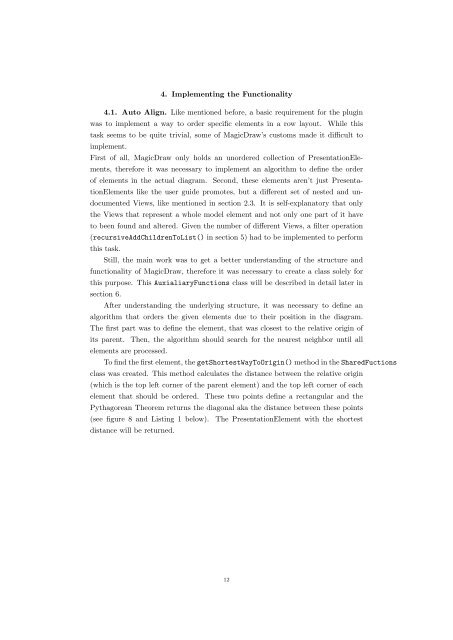A MagicUWE Extension for Semi-Automatic Layout ... - UWE - LMU
A MagicUWE Extension for Semi-Automatic Layout ... - UWE - LMU
A MagicUWE Extension for Semi-Automatic Layout ... - UWE - LMU
Create successful ePaper yourself
Turn your PDF publications into a flip-book with our unique Google optimized e-Paper software.
4. Implementing the Functionality<br />
4.1. Auto Align. Like mentioned be<strong>for</strong>e, a basic requirement <strong>for</strong> the plugin<br />
was to implement a way to order specific elements in a row layout. While this<br />
task seems to be quite trivial, some of MagicDraw’s customs made it difficult to<br />
implement.<br />
First of all, MagicDraw only holds an unordered collection of PresentationEle-<br />
ments, there<strong>for</strong>e it was necessary to implement an algorithm to define the order<br />
of elements in the actual diagram. Second, these elements aren’t just Presenta-<br />
tionElements like the user guide promotes, but a different set of nested and un-<br />
documented Views, like mentioned in section 2.3. It is self-explanatory that only<br />
the Views that represent a whole model element and not only one part of it have<br />
to been found and altered. Given the number of different Views, a filter operation<br />
(recursiveAddChildrenToList() in section 5) had to be implemented to per<strong>for</strong>m<br />
this task.<br />
Still, the main work was to get a better understanding of the structure and<br />
functionality of MagicDraw, there<strong>for</strong>e it was necessary to create a class solely <strong>for</strong><br />
this purpose. This AuxialiaryFunctions class will be described in detail later in<br />
section 6.<br />
After understanding the underlying structure, it was necessary to define an<br />
algorithm that orders the given elements due to their position in the diagram.<br />
The first part was to define the element, that was closest to the relative origin of<br />
its parent. Then, the algorithm should search <strong>for</strong> the nearest neighbor until all<br />
elements are processed.<br />
To find the first element, the getShortestWayToOrigin() method in the SharedFuctions<br />
class was created. This method calculates the distance between the relative origin<br />
(which is the top left corner of the parent element) and the top left corner of each<br />
element that should be ordered. These two points define a rectangular and the<br />
Pythagorean Theorem returns the diagonal aka the distance between these points<br />
(see figure 8 and Listing 1 below). The PresentationElement with the shortest<br />
distance will be returned.<br />
12



